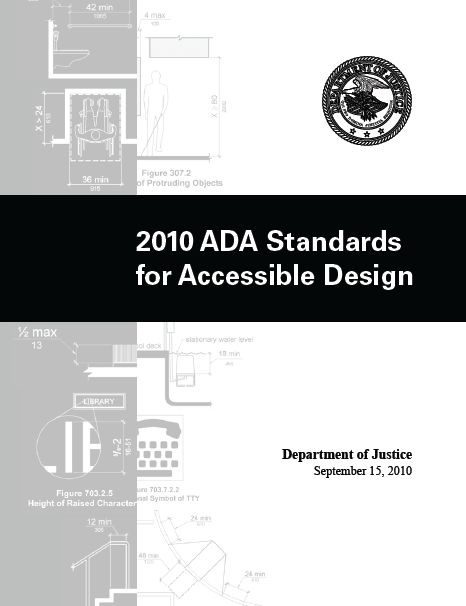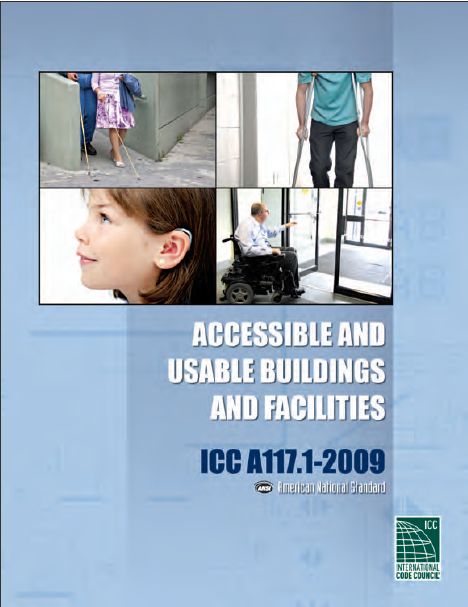 The 2010 ADA Standards for Accessible Design, effective in March of 2012, included an unexpected change regarding the maximum allowable force to operate door hardware. This modification to the standards was made as an “editorial change,” which is typically used to address errors or make clarifications that do not affect the scope or application of the code requirements. Editorial changes do not go through the normal code development process including committee hearings and opportunities for public comment.
The 2010 ADA Standards for Accessible Design, effective in March of 2012, included an unexpected change regarding the maximum allowable force to operate door hardware. This modification to the standards was made as an “editorial change,” which is typically used to address errors or make clarifications that do not affect the scope or application of the code requirements. Editorial changes do not go through the normal code development process including committee hearings and opportunities for public comment.
Prior to the 2010 edition, the ADA standards required door hardware to have “a shape that is easy to grasp, and does not require tight grasping, tight pinching, or twisting of the wrist to operate.” No force limitation was mentioned with regard to the operation of hardware. In fact, the paragraph relative to door opening force (different from operational force) stated that interior, non-fire-rated doors must have a maximum opening force of 5 pounds, but clarified the requirement by stating, “These forces do not apply to the force required to retract latch bolts or disengage other devices that may hold the door in a closed position.” This statement made it clear that the 5-pound force that applies to opening a door, does not apply to the operation of the hardware.
The 2010 edition of the ADA standards changed the paragraph on door hardware to the following:
404.2.7 Door and Gate Hardware. Handles, pulls, latches, locks, and other operable parts on doors and gates shall comply with 309.4. Operable parts of such hardware shall be 34 inches (865 mm) minimum and 48 inches (1220 mm) maximum above the finish floor or ground. Where sliding doors are in the fully open position, operating hardware shall be exposed and usable from both sides.
(Refer to the standard for exceptions.)
By referencing paragraph 309.4, a limit for the operational force of hardware was established:
309.4 Operation. Operable parts shall be operable with one hand and shall not require tight grasping, pinching, or twisting of the wrist. The force required to activate operable parts shall be 5 pounds (22.2 N) maximum.
The problem with this force limitation is that existing codes and standards include different limits for the operation of door hardware. For example, ANSI BHMA A156.2 – Bored and Preassembled Locks and Latches includes a torque limit of 28 lbf-in for levers, while the various codes and standards applying to panic hardware require a maximum of 15 pounds to release the latch (the International Building Code, the International Fire Code, NFPA 101 – The Life Safety Code, UL 305 – Panic Hardware, and ANSI BHMA A156.3 – Exit Devices). There is no known panic hardware* that will consistently release with 5 pounds of force, and the modifications necessary to meet the 5-pound limit would almost certainly affect security and the ability of the panic hardware to withstand severe weather conditions like hurricanes and tornadoes.
When I read the 2010 edition of the ADA standards it seemed like a conflict that the standard would require door hardware to be operable with 5 pounds of force, but would also state that the 5-pound maximum opening force does not apply to the force required to retract the latches, so I contacted Marsha Mazz, Director – Office of Technical and Information Services, at the U.S. Access Board to ask her opinion. Here is her response to my suggestion that there was a conflict in the standards:
“Your analysis is correct. The change was intended to be editorial. Section 4.13.9 of the 1991 ADA Standards duplicated the first sentence of Section 4.27.4 but did not include the second sentence which includes the 5 lbf maximum requirement. The new standards cross reference to sections rather than duplicating them. The problem was not noted until long after the rule was final. We should be able to address this in the next edition. We have not, as yet, developed a schedule for revisions.”
When I asked Marsha when we might see the change in the ADA standards to correct the conflict, she responded:
“I don’t work for the Department of Justice and cannot speak for them. Our guidelines are developed using the same federal procedures as most other agencies, so I cannot say what the outcome of any rulemaking we undertake might be since it is subject to notice and public comment. However, I will recommend removing the second sentence requiring operation to be a maximum force of 5 pounds.”
 While researching this issue and attempting to understand the intent, I looked into the change proposals for ICC A117.1 – Accessible and Usable Buildings and Facilities. This is the accessibility standard that is referenced by the International Building Code, and therefore applies to most new construction projects. In 2008, a proposal to establish force limitations for hardware was submitted but did not pass, and the 2009 edition of that standard does not include a maximum force for the operation of hardware. Some of the reasons cited for rejecting the proposal included:
While researching this issue and attempting to understand the intent, I looked into the change proposals for ICC A117.1 – Accessible and Usable Buildings and Facilities. This is the accessibility standard that is referenced by the International Building Code, and therefore applies to most new construction projects. In 2008, a proposal to establish force limitations for hardware was submitted but did not pass, and the 2009 edition of that standard does not include a maximum force for the operation of hardware. Some of the reasons cited for rejecting the proposal included:
- No evidence or explanation of why a force limit should be included or what that limit should be.
- Existing national standards with reasonable limits that vary depending on the type of hardware.
- The change would render most existing and available hardware non-compliant.
- Effects on proper operation, security, resistance to weather conditions, and safe egress.
A proposal has been submitted for the next edition of A117.1, to establish a limit for the operational force of hardware. This proposal has not yet been approved, and may be revised at the hearings in July:
404.2.6 Door Hardware. Handles, pulls, latches, locks, and other operable parts on accessible doors shall have a shape that is easy to grasp with one hand and does not require tight grasping, pinching, or twisting of the wrist to operate. The operational force to retract latches or disengage devices that hold the door in a closed position shall be as follows:
1. Hardware operation by a forward, pushing or pulling motion: 15 pounds (66.7 N) maximum
2. Hardware operation by a rotational motion: 28 inch-pounds (315 N·cm) maximum
Operable parts of such hardware shall be 34 inches (865 mm) minimum and 48 inches (1220 mm) maximum above the floor. Where sliding doors are in the fully open position, operating hardware shall be exposed and usable from both sides.
EXCEPTION: Locks used only for security purposes and not used for normal operation are permitted in any location.
Given the fact that the change to the ADA standards was meant to be an editorial change, the recommendation from the Access Board that the 5-pound operational force requirement be removed, the attempt to standardize A117.1 with the limits of the existing codes and standards, and the lack of products, particularly panic hardware, that will operate with 5 pounds of force, it seems to me that this change was made in error. It’s nearly impossible to enforce with no available products that are compliant. It could be quite a while before the ADA standards are revised, and until then it will be left up to the local Authority Having Jurisdiction. I hope that the resources cited in this article will help to establish the intent of the accessibility standards with regard to the operational force of door hardware.
*Although there was no known panic hardware that would operate with 5 pounds of force when this article was written, the Von Duprin AX device is now certified to operate with 5 pounds of force or less.
UPDATE:
The 2013 California Building Code has incorporated the same reference as the 2010 ADA, requiring hardware to operate with 5 pounds of force. This code goes into effect on January 1st, 2014.
11B-404.2.7 Door and Gate Hardware. Handles, pulls, latches, locks, and other operable parts on doors and gates shall comply with 11B-309.4. Operable parts of such hardware shall be 34 inches (865 864 mm) minimum and 48 inches (1219 mm) 44 inches (1118 mm) maximum above the finish floor or ground. Where sliding doors are in the fully open position, operating hardware shall be exposed and usable from both sides.
EXCEPTIONS:
1. Existing locks shall be permitted in any location at existing glazed doors without stiles, existing overhead rolling doors or grilles, and similar existing doors or grilles that are designed with locks that are activated only at the top or bottom rail.
2. Access gates in barrier walls and fences protecting pools, spas, and hot tubs shall be permitted to have operable parts of the release of latch on self-latching devices at 54 inches (1370 1372 mm) maximum above the finish floor or ground provided the self-latching devices are not also self-locking devices and operated by means of a key, electronic opener, or integral combination lock.
11B-309.4 Operation. Operable parts shall be operable with one hand and shall not require tight grasping, pinching, or twisting of the wrist. The force required to activate operable parts shall be 5 pounds (22.2 N) maximum.
EXCEPTION: Gas pump nozzles shall not be required to provide operable parts that have an activating force of 5 pounds (22.2 N) maximum.
UPDATE 2: This requirement has not been removed from the ADA standards, and no official comment has been received from the Access Board, so the 5-pound force limitation has become more widely enforced. The 2017 edition of A117.1 includes different force limitations for door hardware, but this standard has not yet been referenced by the model codes. There is additional information in this Decoded article.
If you have been involved in an attempt to enforce this requirement, how was it resolved?
You need to login or register to bookmark/favorite this content.





Lori,
Thank you for always making us aware of these issues. I’m so glad we have a code guru looking out for us! Keep up the great job!
Mary
Thanks Mary. Some areas of the country have really been struggling with this, so I’m trying to address it.
Dear Lori
Nice job, but don’t hold your breath until it’s remedied.
Lets just hit the delete key.
Art
I’d misread a copy I’d gotten last June of the “Final Express Terms For Proposed Building Standards Of the Division of the State Architect Regarding the California Building Code California Code of Regulations, Title 24, Part 2, 2013 California Building Code”. In my first reading, there appeared to be a contradiction and I’d missed how serious this really is. This document is basically how the new code will read unless it is somehow amended at this late date, and it does indeed include the reference back to the 5lb-to-operate clause, which is located in Division 3 “Operable Parts” at 309.4, and making it applicable to door hardware at 404.2.7: “Handles, pulls, latches, locks, and other operable parts on doors and gates shall comply with 11B-309.4.”
It’s going to get interesting out here in ’14, we really don’t know how to comply without expensive electrification, including back-up power. Really don’t know how this will be enforced…
Since it is a mistake, it is not enforced. There is no maximum force for door hardware in the accessibility standards.
Hi Larry –
I’ve actually seen quite a few AHJs enforcing the 5-pound requirement. The DOJ has had 5 years to address the mistake but they have not done anything official. It will be resolved eventually, one way or the other, but for now it is left up to the interpretation of the AHJ.
– Lori
Hi Lori, is there an update to this requirement with 2019 California Building code?